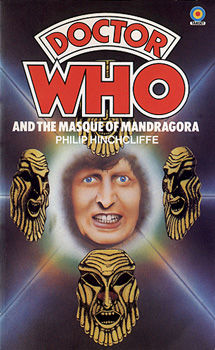The Masque of Mandragora
Doctor Who and the Masque of Mandragora

|
The Masque of Mandragora |
Target novelisation Doctor Who and the Masque of Mandragora |

|
| Author | Philip Hinchcliffe |  |
| Published | 1977 | |
| ISBN | 0 426 11893 6 | |
| First Edition Cover | Mike Little |
| Back cover blurb: Forced off course by the Mandragora Helix, the Tardis lands in the province of San Martino in fifteenth-century Italy. Here, the court astrologer, Hieronymous, has been taken over by the Mandragora energy-form - Hieronymous and the other members of his star-worshipping black magic cult will be used as a bridgehead, enabling the Mandragora Helix to conquer the Earth and rule it through their chosen servants. The Doctor has to defeat not only the Mandragora energy, but the evil schemes of the murderous Count Frederico who plans to usurp the place of his nephew, the rightful ruler of the province. |
Oh dear by Tim Roll-Pickering 2/3/04
One of the weakest of all the stories produced by Philip Hinchcliffe is The Masque of Mandragora, which although it has some good production values it suffers from a very poor storyline, revolving heavily around a boring "young ruler must fend off the ambitions of wicked uncle" whilst the Mandragora Helix itself goes unexplained and the ending is rushed and unclear, with the result that the whole tale falls flat. In novelised form the story automatically loses the production values, but it does at least gain the prospect of having both the menace and the ending more clearly defined. Surprisingly the novelisation is produced by Hinchcliffe himself, which is already a worrying sign as his first adaptation, Doctor Who and the Seeds of Doom, was competent but left the impression that it could have been so much more. Given the experience gained in producing that book does this mean that his second novelisation is much better and really stands out?
Unfortunately the answer is no, and instead Doctor Who and the Masque of Mandragora is easily the most tedious of all the novelisations released in the first five years of Target. In part the problem stems from the basic flaws in the structure of the story, making it an uphill struggle for any adaptor to novelise, but there are other weak television stories that had already been turned into highly competent novelisations by this point, such as Doctor Who and the Claws of Axos. What makes this even more of a shock is that Hinchcliffe does try to make the book feel like more than just an adaptation of the camera scripts by providing little enhancements, but time and again this fail to come off. What is especially tedious is the way in which he repeatedly makes the point that none of the local characters can understand some of the Doctor and Sarah's euphemisms even though elsewhere the point is made that language is never a barrier for them. The precise nature of the Mandragora Helix gets no further explanation here either and what is especially puzzling are its comments that it needs to avert the course of development on Earth in case humanity ever ventures into space and threatens it, which comes across like an intelligent dinosaur going out of its way to destroy a puny ape purely in case its descendants evolve into the dominant species on the planet.
Hinchcliffe's writing style is competent but rarely exciting. The Doctor is at least more in character in this book than in Doctor Who and the Seeds of Doom but that is primarily because of the source material and the Doctor still comes across as harsh, especially when he lures the brethren into a trap. There are very few Doctor Who books that are a real struggle to read but Doctor Who and the Masque of Mandragora is easily one of them. Time and again whilst reading it for this review I found myself wanting to give up, finding no real enjoyment in it whatsoever (and only continuing for the sake of writing a complete review). At the end of the day this is a highly forgettable novelisation. 1/10